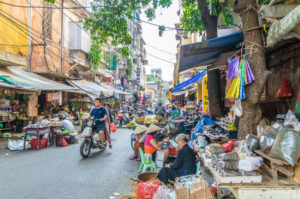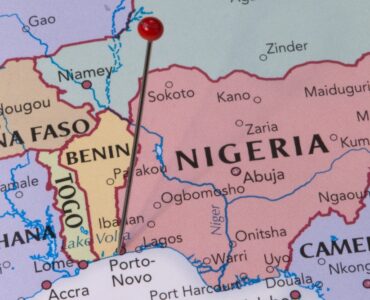In common with most markets anywhere in the world, Vietnam’s markets are very colourful, vibrant places that teem with cheerful, enthusiastic vendors and savvy, bargain hunting buyers. The larger Vietnamese markets, as can be found in most large towns and cities, generally sell all manner of things such as clothing, shoes, hats, kitchen utensils, rolls of silk and other cloth. Of course, now souvenirs are also prominently displayed to specifically meet the perceived demands and requirements of the tourist.
Market vendors in Vietnam are very often extremely persistent and very persuasive almost to the point of hustling-especially when they catch sight of a Western face. Depending on your haggling skills, however, the price for that T shirt, pair of jeans, silk or exquisite piece of lacquerware can prove to be irresistible. Many of the vendors speak English, so getting around the negotiations should not be an issue for the English-speaking and western traveler.

As interesting as the tourist sections of the markets are for the discerning shopper, it is really the fresh produce and food sections that are the most fascinating in terms of Vietnamese culture. They are full of both mundane and exotic fruits, vegetables, fish, meat, flowers, spices and other foodstuffs. The vendors themselves are often very colourful characters who seem to spend all their waking hours selling their wares on the market in between bouts of conversation, laughter, snoozing and eating. Sometimes, they sit and stare, looking very bored when business is slow, but they are also frequently in animated conversations with either a customer or a neighbouring vendor. Often, it seems that they are involved in some form of ribald repartee which results in cackling laughter that reverberates across the market and spreads to the nearby stallholders like a Mexican wave.
Most food markets are open at some ungodly early hour but often stay open into the afternoon. They are usually divided into different sections such as meat, fish, dry goods, fruit and vegetables, and can be covered or uncovered. Often where there is a designated covered market, stalls and vendors spill out onto the surrounding streets trying to catch buyers both arriving and leaving the official market area. Towns and cities have many markets but, at times, it seems that if a piece of ground is cleared, then a makeshift market will very quickly appear. Just like everyone else, the Vietnamese love a bargain and where better to find that elusive bargain than at the market?
Soak in the Colours of the Fruits and Vegetables
The fruit and vegetable section of the market is usually the most colourful with pink dragon fruit vying for space with red and yellow fleshed melons, green pomelos, yellow bananas and not unsurprisingly, orange oranges, although even some of these are green! Of course, there are more exotic Asian fruits less familiar to Westerners such as custard apple, durian, guava and rambutan. There is also the ubiquitous and delicious mango in both green (unripe), which is used in salads, and yellow (ripe) dessert varieties. The vegetable stalls are almost as colourful with green cucumber, white cabbage, red tomatoes, purple eggplant, orange carrots yellow Japanese pumpkins and a large number of vegetables of all shapes and sizes the names of which I have no idea. Many of the vegetables to the Western eye are unusual to say the least – exceedingly long green beans, knobbly looking cucumbers, strange looking globes in different colours and bunches of leaves with and without stems.
Fish Galore
The fish section is, as can be imagined, rather a wet, smelly and slimy place. But it’s also home to some captivating sights. Live catfish from the rivers can be seen splashing around and occasionally jumping out of their confinement to wriggle and slither across the floor in a desperate attempt to escape. There are live crabs, claws restrained by elastic bands with jet black eyes on stalks twitching and seemingly pleading for help. Live eels blissfully writhe around in ignorance of their fate. There is a huge variety of fish – tuna, mackerel, sea bass, mullet, grouper, tubtim, sardines and many others, some of which are colourful and some which are rather scary looking specimens. Molluscs too are there in numbers – squid, octopus, mussels, scallops, cockles and clams together with the crustacean family of lobster, crayfish, shrimp and prawns in addition to the already mentioned crabs in their different guises.
Watch out for the meat
For the Western visitor more familiar with meat sold from sanitised, refrigerated counters at the butchers, or in the supermarket, the sale of meat and poultry from open stalls in 30 degree-plus heat with no refrigeration in sight is a somewhat sobering thought. Despite the many health precautions and regulations surrounding meat in Western countries, there are still cases of food poisoning, and in Vietnam, there would appear to be few rules to prevent bacteria from infecting meat and poultry to the ultimate cost and discomfort of the consumer. In some cases, some of the potential problems are obviated by the selling of live chickens and piglets. However, the sight of so much blood and raw flesh being chopped in some of the larger markets is perhaps not for the faint hearted, especially as the Vietnamese predilection for dog meat can be rather shockingly displayed.
 Of course, the other classic ingredients of Vietnamese cuisine are much in evidence, from sacks of rice and noodles, to fish and soy sauce, to a profusion of the herbs that are so commonly found in Vietnamese cuisine such as mint, coriander, lemongrass, basil not forgetting the usual oriental spices such as ginger, chili, turmeric and cardamon.
Of course, the other classic ingredients of Vietnamese cuisine are much in evidence, from sacks of rice and noodles, to fish and soy sauce, to a profusion of the herbs that are so commonly found in Vietnamese cuisine such as mint, coriander, lemongrass, basil not forgetting the usual oriental spices such as ginger, chili, turmeric and cardamon.
All the markets are generally busy and there is lots of hustle and bustle with vendors cajoling their customers and announcing the qualities of their wares. Customers jostle for position as porters impatiently huff and puff as they haul or push their laden baskets and trolleys around the place delivering produce. Invariably, cyclos wait on the edges of the markets, their languid drivers waiting patiently to ferry customer and purchases to their destination.
No visitor to Vietnam should miss a trip to the fresh produce and food markets, or wet markets as they are frequently known in order to gain an insight into Vietnamese culture and daily life. These markets exist for the benefit of the locals and not the tourists and as such remain largely unsullied of tourist considerations and are indeed representative of the true Vietnamese lifestyle as has been practised for centuries.
Click here for information on Vietnamese translation services.





